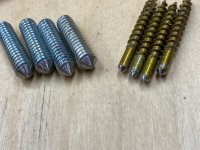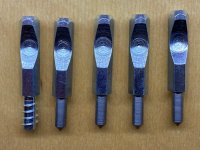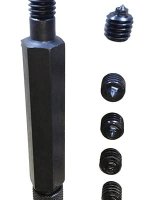Birdhunter
Member
- Joined
- Jun 16, 2012
- Messages
- 4,144
I saw a set of transfer punches on a YouTube machinist video. He was marking holes to mount an enormous vise onto a metal table. The holes had to be exactly located.
I did some research and settled on a full set. The trick is that the transfer punches fit perfectly in to the hole. They have a hardened point on one end. You give the transfer punch a light hit and you get a dimple where you start drilling. Repeat for each hole.
The cheap sets have soft steel and the point goes away after a couple of hits. Some cheap sets have the point not exactly on center and that throws the hole pattern off.
I mostly use the transfer punches on wood, but sometimes on metal.
Neat tool.
I did some research and settled on a full set. The trick is that the transfer punches fit perfectly in to the hole. They have a hardened point on one end. You give the transfer punch a light hit and you get a dimple where you start drilling. Repeat for each hole.
The cheap sets have soft steel and the point goes away after a couple of hits. Some cheap sets have the point not exactly on center and that throws the hole pattern off.
I mostly use the transfer punches on wood, but sometimes on metal.
Neat tool.



